Have you ever wondered why customers choose one retail store over another? Is it the location, product selection, customer service, or something deeper that drives them away, never to return? The truth is, it could be all these reasons—and more. That’s why forward-thinking brands have long adopted the practice of stepping into their customers' shoes to truly understand what motivates their actions.
By digging deeper, the smartest brands don’t just observe—they use tools like buyer personas and customer journey maps to truly get inside their customers’ heads. These tools help businesses not only identify customer needs but also anticipate their thoughts, behaviors, and desires at every step of the customer journey.
Mapping the customer journey allows brands to visualize the entire experience from the customer’s perspective, pinpointing where things go right—and where they go wrong. In this article, we’ll explain how creating buyer personas and building retail customer journey maps help brands fine-tune their strategies and better understand the customer experience. These insights allow businesses to make informed improvements that drive satisfaction and loyalty.
Let’s dive in and explore how you can leverage this approach to improve your retail business.
Contents
Defining your personas
To correctly define your personas, you need to start with the research step (e.g., collect feedback from your customers and customer-facing staff), then segment the data into customer groups and turn them into personas.
What can you do as a part of your research?
- Conduct surveys to gather data on the age, gender, location, income, and occupation of your customers. For instance, use online forms or in-store questionnaires to collect this information.
- Observe customer behavior in your store. Note what people purchase, how often they visit, and which sections of your store they frequent.
- Examine customer purchase history using your point-of-sale system to understand their buying patterns and preferences. This data can reveal what products are most popular.
- Create feedback forms or comment cards in your store, and encourage customers to share their opinions and suggestions. Analyze the feedback for common themes.
- Monitor online reviews and social media mentions related to your store. Pay attention to what customers say about their experiences and what they like or dislike. This feedback is especially valuable for understanding the food buyer's journey, as it highlights specific pain points or areas of delight in your offerings.
- If you have an online presence, use website analytics tools to track user behavior. Analyze data on page views, click-through rates, and time spent on different sections of your website. For the food buyer journey in retail, focus on which products or categories get the most engagement and where potential buyers might drop off.
- Conduct one-on-one or group interviews with customers to gain deeper insights into their motivations, challenges, and preferences. Ask open-ended questions to encourage detailed responses.
- If you have a loyalty program, use the data collected to understand customer loyalty and their purchase habits. Loyalty programs can help map the food buyer journey in retail by identifying your most dedicated customers and their shopping patterns, revealing opportunities to enhance their experience.
- Utilize third-party market research and consumer behavior data to complement your in-house research. This can provide a broader perspective on your audience, as the same people often buy from many companies in the market. That’s why you can even study the customer personas of your competitors, as this can provide insights into what similar customers might expect from your retail food store.
Once done, choose the persona(s) you will build a map for. The choice depends on your priorities. This can be the most profitable persona, or the one who visits your store more often than others, or the one who stops coming to the shop after a couple of visits. Each will have an individual journey and unique challenges.
Building a customer journey map for a food retail
Before diving into each stage of the journey, it's important to understand how to structure your retail customer journey map effectively.
First of all, you need to define the journey stages of a persona you decided to build a map for. Remember, a customer's journey doesn't start when they step into the store; it begins way before that when they realize they need something. So, if you want to understand the whole journey, don't forget that early part.
As we go stage by stage, we’ll break down every step of the customer’s experience, starting from their initial need all the way to post-purchase engagement. We’ll discuss how each stage impacts the overall shopping journey and suggest key sections you should include in your map, such as customer actions, pain points, emotions, and opportunities for improvement. This detailed approach ensures you’re not only mapping out the journey but also building a foundation for actionable insights that will enhance customer satisfaction and loyalty.
For this article, we built an end-to-end customer journey for a food retail store. Read on to get an idea of what your own map might look like.
Stage 1: Research
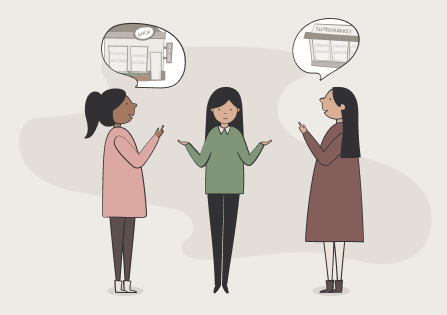
Your persona understands their need in a couple of ways. It could be that their home is running low on food supplies, and they realize it's time to restock the pantry and refrigerator. Alternatively, they might have a special event, like a gala dinner, on the horizon, and they recognize the need to purchase specific ingredients to prepare for the occasion. Or maybe the persona has rented a flat from a real estate agency and moved to it.
Our persona’s name is Olivia. She recently moved to a new area and, of course, her refrigerator is empty, but she is not yet familiar with the new location. What is Olivia doing? Asks for advice from neighbors.
Notice how the grocery shopping experience of other customers affects Olivia’s journey.
So, what do you need to reflect on at this stage of your persona's journey? Focus on the process: how they realize their need, how they seek to fulfill it, through what channels, the emotions they experience, their expectations, and how they interact with your business. This is essential for mapping out the retail store customer journey effectively.
After outlining these in your map’s sections, identify any challenges your persona might face at this stage in the customer journey retail store. You should also do this for all other stages. Even if you don’t find room for improvement at every step, recognizing your business’s strengths will help you enhance those areas and use them to your advantage.
These same sections should be filled out for each subsequent stage of your persona’s journey, allowing for a comprehensive understanding of how customers engage with your retail store across the entire journey.
Stage 2: Decision
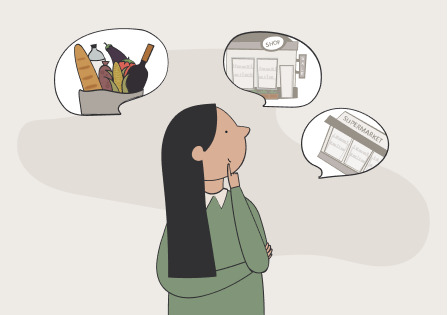
After receiving the necessary information, your persona faces a choice since there is always more than one store nearby. What can work against you? What, on the contrary, will make you stand out from other options?
For example, Olivia chooses a supermarket, although it’s located further away than the local store. Why? Because she needs a rare product that can’t be found in small stores.
Always notice what drives the persona to choose in your favor, as these are your strengths, which you can emphasize in advertising materials. Likewise, address consumers’ concerns, as these are opportunities for growth and improvement.
Stage 3: Getting to the supermarket
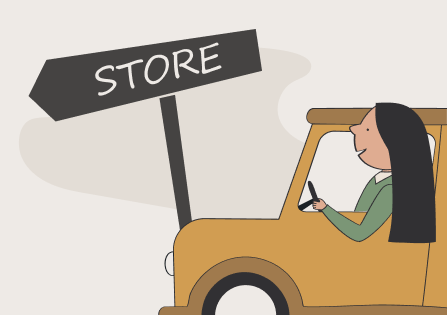
It's time for the persona to reach your physical store. How easy is it for them to find the way? Are there any billboard advertisements on the road pointing toward the store? And what are the transportation options—can they arrive by car, bus, taxi, or on foot?
In our case, Olivia is driving her own car, and her main concern is navigation. She takes a few wrong turns, which begins to negatively impact her shoppers journey before she even reaches the store. This shows how the experience at a physical store can start long before the customer enters the building—poor navigation can affect their perception and overall experience, setting a negative tone for the visit.
Stage 4: Arrival
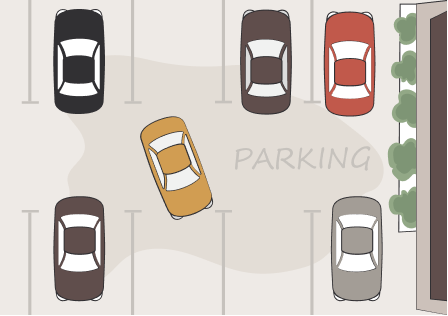
So, your persona arrives at the store. What's there for them? Underground parking? Endless chaos and searching for a parking space? Lack of parking? Paid parking?
Olivia is lucky — the supermarket has a parking lot. But finding a parking place is not that easy. It’s vital to understand the approximate flow of customers in your store. Is your parking large enough to accommodate all visitors' cars?
If a buyer is looking for a parking place for too long, they enter the store in a bad mood, and this definitely affects their grocery shopping experience, as well as the desire to return.
Stage 5: Pre-entry
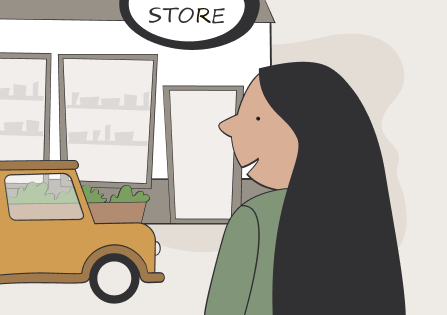
It may seem like nothing significant happens during the short leg of a shoppers journey from a car, bus stop, or traffic light to the physical store door, but this stage is often overlooked at a brand’s peril. Have you ever considered the potential hazards lurking in the parking lot, like a minefield of moving vehicles between the customer's car and the entrance?
For example, Olivia is nearly hit by a car on her way to the store. A situation like this can easily spoil her shoppers journey before she even steps foot inside the physical store. This highlights the importance of ensuring customer safety—installing pedestrian crossings or even traffic lights in large parking lots can be crucial for creating a smooth and secure journey from parking to the store entrance.
Stage 6: At the supermarket
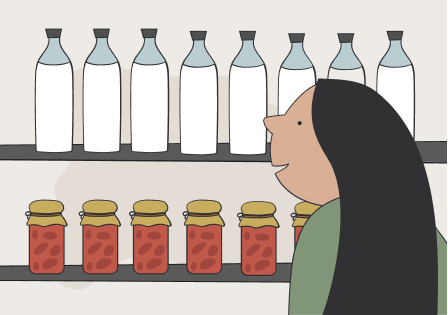
Finally, your persona, Olivia, is inside the store. What do they see? Is the layout easy to navigate? Even in familiar supermarkets, there are frequent rearrangements, causing potential customers to search for their favorite products again. Are there helpful staff members available? Are there enough shopping carts or smaller baskets for those only picking up a few items?
Olivia is struggling to find a product, and store employees are unable to assist. To make matters worse, the sections of the store lack signage, making navigation difficult. This not only hampers the retail experience but also leaves potential customers feeling frustrated. A simple solution could be the installation of interactive displays or electronic maps of the store layout. These digital solutions can be updated quickly to reflect any changes in the store’s merchandise layout, offering customers a convenient way to help themselves.
Stage 7: Purchase
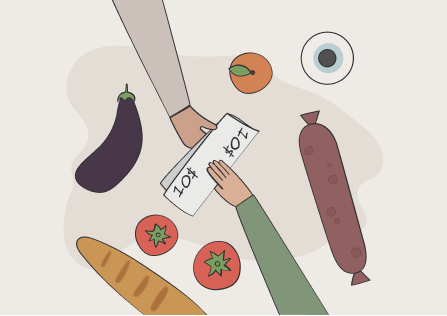
The moment of purchase. Sometimes shopping is very enjoyable, but the primary headache awaits at the checkout. Are there enough checkouts in your supermarket? Are you increasing the number of cashiers during peak hours? Does the store have self-checkouts? At this stage, another problem may arise, the payment process. Do you accept all credit cards? Can a customer use a discount coupon?
Olivia, approaching the cash register, realizes that she will have to stand in a huge queue. She notices information about the discount program but cannot find out the details until her turn comes up. On the one hand, that's good, as you managed to draw the buyer’s attention to a beneficial part of your service. Adding a QR code, via which the customer can immediately register in the program, will help to while away the time in the queue and the future discount will compensate for the waiting time.
Stage 8: Leaving
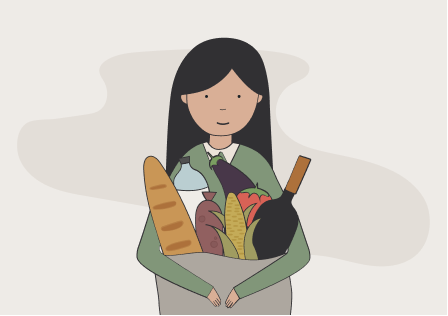
Well, the buyer paid for their groceries, and now they somehow need to leave the store and either bring the purchase to the car or even at home. Consider if you have staff to help them carry the bags to a vehicle or if you have special carts. How strong are the bags in which you pack the purchases? Can they tear up while the customer walks home? It would be a good idea to provide a paid service of transferring a buyer to their house, highlighting your store among similar ones. This service can be free for people with huge bills.
Although Olivia arrived in her car, she still needs to put her purchase in the trunk, and the bags were quite heavy. There are no assistants among the staff, and she has heard that the carts couldn’t be taken out of the store. Olivia may turn to other buyers for help, but her grocery store experience with you will be spoiled.
Stage 9: Bonus program
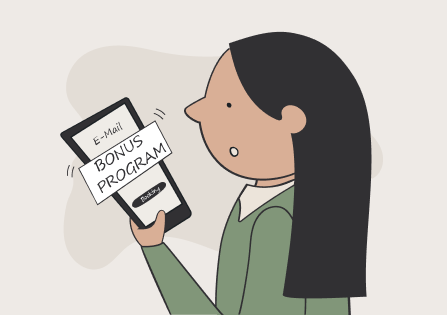
Let's say you have a bonus program or some other loyalty system. The buyer finds out about it and tries to register. What could go wrong? Everything. The application may not launch, it may contain bugs, and the loyalty system itself may be too complex, so the buyer decides to give up.
Olivia finds more detailed information about your bonus program on the Internet, and wants to install the application, but it is not compatible with her device. She doesn’t plan to change her smartphone in the near future, but she also wants to get a discount.
How can you help? Offer customers to register their personal accounts not only in the application but also on the website. Accrue bonuses by the buyer's phone number or issue plastic cards as an e-card replacement. This way, you will cover the maximum number of your customers, including not very tech-savvy people, or children who were sent to the store by their parents, and so on.
Stage 10: Coming back
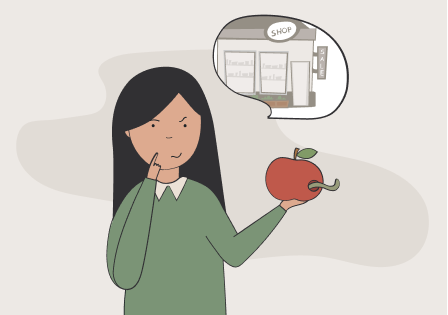
This stage is no less significant than all the previous ones since the buyer can always change their mind and not return. Will the persona want to return to your store?
Everything that we talked about above influences their decision. But additional factors may appear. For example, the persona enjoyed their grocery store experience, but in a conversation with friends it turned out that they were less fortunate in your service. Someone else’s problem may affect this persona’s opinion. Or pretty ripe apples from your store turn out to be not so pretty on the inside. Or maybe your work schedule will not fit into the rhythm of the buyer’s life.
Olivia decides to return. After all, where else would she buy quinoa? She already finds it easier to navigate the supermarket, but the long queue at the checkout is still annoying. Olivia came during the hours when the bulk of people were at work, but this did not affect the queues in any way.
How many chances will Olivia give your store? How soon will she know that there is another large supermarket nearby? Are you sure she won’t become their client?
Analyzing a customer journey map for a food retail
Once the map is ready, use it to understand what needs to be improved to encourage your customers to choose and stay with you. Put this information into action, and it won’t take long to see the result. This is where mapping reveals the true "moments of truth," those critical points in the journey where customer experience makes or breaks loyalty. By visualizing these moments, you transform scattered data into clear, actionable insights. Mapping doesn't just tell you what you already know—it structures it so you can communicate these insights across your team, ensuring that everyone is on the same page and aligned in their approach.
A comprehensive customer journey map should have multiple layers that provide a detailed view of the customer experience. These layers typically include:
- Customer actions. This layer outlines what actions customers take at each stage of their journey, from research to purchase. It highlights where customers engage with your brand and can reveal friction points, such as a cumbersome checkout process.
- Touchpoints and channels. This layer identifies all the channels through which customers interact with your business, such as physical stores, websites, mobile apps, and social media. Understanding these touchpoints helps in ensuring a seamless experience across all platforms. Without mapping, these interactions might remain uncoordinated, leading to inconsistencies that can frustrate customers.
- Emotions and pain points. Mapping the emotional journey of customers helps identify where they feel excited, frustrated, or confused. For example, frustration during the checkout process can be identified and addressed by adding more payment options or improving staff availability. These insights often serve as the ‘aha’ moments—clear indicators of where immediate improvements can transform the overall experience.
- Opportunities for improvement. This section highlights actionable areas where your store can improve. It could involve adding more signage, improving navigation in-store, or offering personalized promotions. Mapping these opportunities ensures that every identified gap is paired with a plan, making improvements more systematic and trackable.
- Embed sections. Embedding additional information, such as screenshots of the website, notes from customer interviews, or examples of marketing campaigns, adds context and helps visualize specific issues. This can make the map more interactive and actionable for your team. These visual cues ensure that the insights aren't just abstract concepts but grounded in real, observable examples that everyone can understand and rally around.
Metrics to monitor and analyze
Incorporating metrics into your journey map adds a quantitative layer that can validate your insights and drive data-driven decisions. Key metrics to consider include:
- Conversion rates. Track how effectively customers move from one stage of the journey to the next, such as from awareness to purchase.
- Customer satisfaction. Use surveys and feedback forms to measure customer satisfaction at different touchpoints.
- NPS. Measure how likely customers are to recommend your store to others, indicating overall satisfaction and loyalty.
- Time spent. Analyzing how much time customers spend at each stage can highlight potential friction points that need addressing.
- Churn rate. Monitor the percentage of customers who stop engaging with your store after a particular point, which can signal areas that need improvement.
Benefits of analyzing food retail customer journey maps
- By diving into each layer of the map, you gain a holistic understanding of the customer's experience, enabling you to address specific pain points and enhance positive interactions.
- The map helps prioritize areas for improvement. For instance, if the data shows that customers frequently abandon carts due to long checkout lines, you can take action by adding more checkout lanes or implementing self-checkout kiosks.
- Analysis of the journey map can reveal strategies to enhance the customer experience, keeping them engaged and encouraging repeat visits. This could involve loyalty programs, targeted promotions, or simply improving in-store navigation.
- Embedding metrics into the map allows for decisions grounded in real data rather than assumptions. This strategic approach helps in resource allocation, ensuring investments are made in areas that directly impact the customer experience.
- Journey maps provide valuable information that can be used to refine marketing strategies, personalize customer communications, and enhance product placement, leading to more effective engagement and increased sales.
This approach turns your journey map from a static document into a dynamic tool that continually evolves to meet customer needs.
Sustainable lines
If you want to go beyond the usual customer journey map and pay special attention to some aspects that matter to your case, feel free to add custom sections. In this template, we introduced sustainability-related lines and considered how a retail business interacts not only with the buyers but also with the environment.

Summing up
You might have little to no experience with customer journey mapping, but it’s not as difficult as it seems. Check out our updated Retail food customer journey map template to learn what a customer persona and a customer journey map for your store might look like.
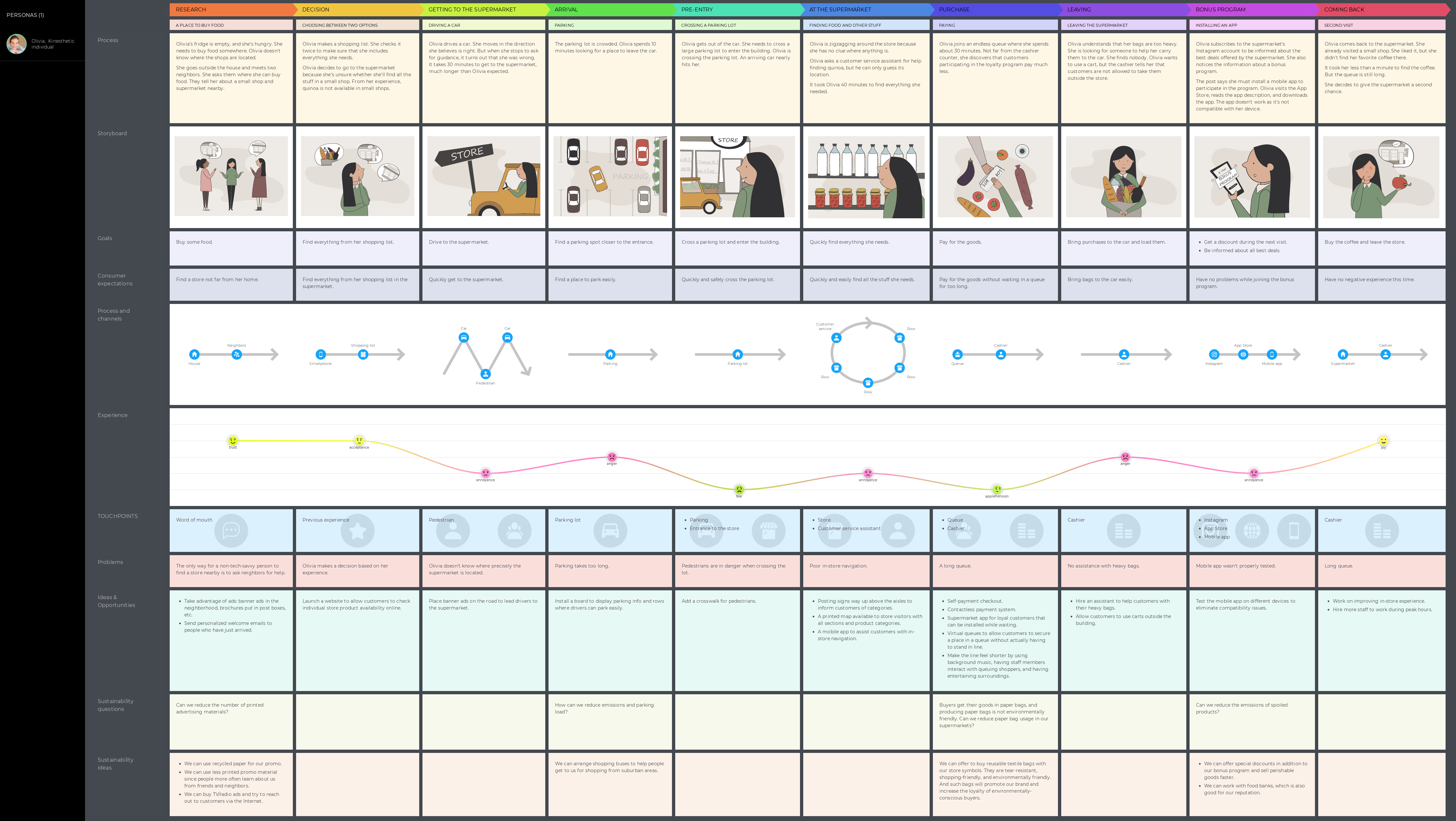
You can easily turn this CJM template into your map if you want by using our CJM tool. And it’s absolutely free.
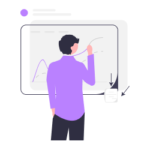
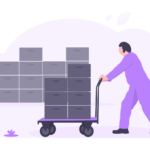
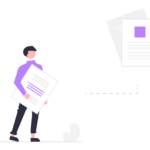



We’re thinking about building a food and beverage customer journey, so this article was useful. Especially the dramatic episode of Olivia nearly getting hit by a car. A bit over the top, but a good reminder that no interaction or opportunity in the customer experience is too small.
Great template. I think there’s a common misconception that the only companies that should be building journeys are digital-only. It’s nice to see an example for a grocery shopping customer journey that’s almost exclusively offline.